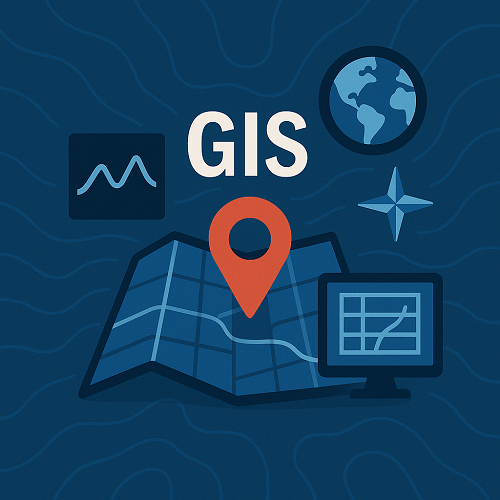- AI-driven GIS and IoT integration are reshaping data collection and spatial decision-making in real time.
- 3D GIS improves urban planning and infrastructure simulation across smart cities.
- Blockchain enhances data authenticity and secure geospatial transactions.
- GIS innovation is central to building climate-resilient and sustainable communities.
- Businesses leverage advanced GIS analytics to reduce risk and discover new opportunities faster.
What’s New Right Now
As of 2025, the Geospatial Information System (GIS) landscape continues to evolve rapidly. Cutting-edge advancements integrate artificial intelligence (AI), real-time Internet of Things (IoT) feeds, and blockchain-secured data sharing. According to Esri, modern GIS platforms now support predictive analytics at unprecedented scales, fueling smarter infrastructure and environmental insights. Similarly, Geospatial World reports a growing interest in 3D GIS modeling for urban planning, disaster response, and renewable energy optimization.
Why It Matters
GIS is no longer a niche mapping tool — it’s an enterprise-wide decision-support system. For businesses, GIS insights drive efficiency in logistics, asset tracking, and location intelligence. Governments increasingly use GIS to manage urban growth, monitor natural resources, and plan climate adaptation strategies. Technically, AI-enabled GIS reduces manual processing time, while IoT sensors provide continuous spatial feedback that enhances real-time decision quality.
Deep Dive: The Core Trends Transforming GIS in 2025
1. AI Integration in Spatial Analysis
Machine learning models embedded in GIS now automate pattern recognition, from vegetation health to traffic anomalies. Predictive geospatial analytics aid in forecasting population shifts or energy consumption patterns, creating proactive urban management systems.
2. The Rise of Real-Time and IoT-Connected GIS
IoT sensors stream location-based data from transportation networks, energy grids, and water systems. This integration keeps maps dynamically updated and provides decision-makers with actionable alerts. According to IoT Analytics, global IoT-GIS convergence grew nearly 30% year-over-year, underscoring its expanding relevance.
3. 3D GIS for Smart Urbanization
Traditional two-dimensional maps cannot fully capture vertical data layers such as building height or underground utilities. 3D GIS enables immersive visualization and analysis of entire cityscapes. By simulating solar exposure, drainage, or telecommunications coverage, planners design more efficient and sustainable urban environments.
4. Blockchain for Geospatial Data Integrity
Distributed ledger technology ensures data traceability and prevents unauthorized edits. As spatial datasets become more valuable, ensuring data integrity through blockchain fosters trust across public and private sectors involved in data sharing.
| GIS Trend | Primary Benefit | Key Challenge |
|---|---|---|
| AI Integration | Automated pattern detection and predictive modeling | Requires high-quality training data |
| IoT-Connected GIS | Real-time insights from field sensors | Data standardization and connectivity |
| 3D GIS | Immersive spatial modeling for cities | High computational demand |
| Blockchain-based GIS | Secure, transparent data exchanges | Limited scalability and interoperability |
Mini Case Study: Building a Climate-Resilient Coastal City
Problem
A coastal municipality faced recurring flood damage and lacked integrated data to plan resilient infrastructure.
Approach
The city implemented a GIS platform integrated with IoT tide gauges and AI-based storm prediction layers. Blockchain was used to validate hydrological data collected from multiple agencies.
Outcome
Within one year, the project reduced flood-related response time by 40% and improved forecasting accuracy by 25%. The analytics dashboard also helped planners prioritize areas for green infrastructure investment, ultimately lowering long-term mitigation costs.
Implementation Checklist
- Define your organization’s spatial data objectives and identify key use cases.
- Assess data availability, quality, and interoperability standards.
- Select a scalable GIS platform supporting AI and real-time data feeds.
- Integrate IoT devices for continuous environmental or operational monitoring.
- Incorporate blockchain or similar data integrity measures where applicable.
- Invest in staff training for GIS analytics and data security best practices.
- Evaluate success metrics periodically to refine GIS strategies.
FAQs
1. What makes modern GIS different from traditional mapping?
Modern GIS integrates AI, IoT, and cloud-based analytics, evolving from static maps to dynamic decision intelligence platforms.
2. How does 3D GIS support infrastructure planning?
3D GIS helps planners simulate construction impacts, optimize land use vertically, and visualize potential risk zones in three dimensions.
3. Can blockchain really benefit GIS data management?
Yes, blockchain provides audit trails, helps verify data origins, and ensures tamper-proof sharing of geospatial datasets among stakeholders.
4. Why is IoT integration crucial for real-time GIS?
IoT integration allows constant data updates, enabling decision-makers to act on live conditions rather than outdated snapshots.
5. What industries benefit most from advanced GIS?
Utilities, transportation, urban planning, agriculture, and environmental management see major ROI through optimized operations and predictive insight.
6. How can small organizations start using GIS effectively?
Cloud-based GIS services provide affordable, scalable options that let smaller teams analyze and visualize data without heavy infrastructure investment.
Conclusion
From climate resilience to resource optimization, GIS now stands at the intersection of technology and sustainability. As these innovations mature, organizations embracing AI, IoT, and blockchain within their GIS frameworks will build smarter and more adaptive systems. For expert guidance, explore our GIS services and transform location data into actionable intelligence for the future.
